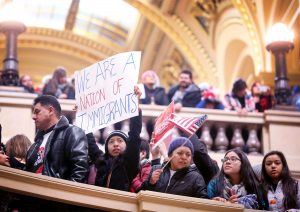By Martin Macias, Jr.
Extra News
CHICAGO — On Sept. 17 in New York City over 2,000 people began protesting nonviolently against corporate influence and against the financial crisis caused by greed and mismanagement of Wall Street firms.
More than one month later, the protests continue to grow and gain attention from politicians locally and nationally. On Sept. 23 a group assembled in Chicago, at LaSalle Street and Jackson Boulevard, in front of the Federal Reserve Bank, to begin Occupy Chicago.
What caused this?
Unemployment and foreclosures compounded the crisis faced by millions in the U.S while Wall Street banks accepted public bailouts and gave themselves bonuses while refusing to lend money.
“The nation’s banks are sitting on a historically high level of cash reserves of $1.64 trillion, but they refuse to help the country,” said LeeAnn Hall, who leads Washington’s Alliance for a Just Society. “Banks must pay their fair share of taxes, and help create jobs through small business loans.”
It has been amazing to see people’s resilience through the rain and cold weather. There are people from all walks of life at Occupy Chicago who are very smart and have visions for what world they want to live in. I’ve noticed a trend of mostly young whites leading a movement that stands to represent the “bottom 99 percent.”
People of color, undocumented immigrants and queer folks are definitely visible in Occupy Chicago but the building toward “safe, accessible and liberated spaces” remains to be seen.
A typical response I hear is that race (or other factors) should not detract from a movement working to bring change to everyone. I counter that an agenda that embraces perspectives and objectives of the historically oppressed communities benefits everyone not only a few.
The absence of racial diversity is particularly troubling given that the larger issues — poverty, foreclosures …
Finish reading What Latinos can gain through Occupy Chicago




